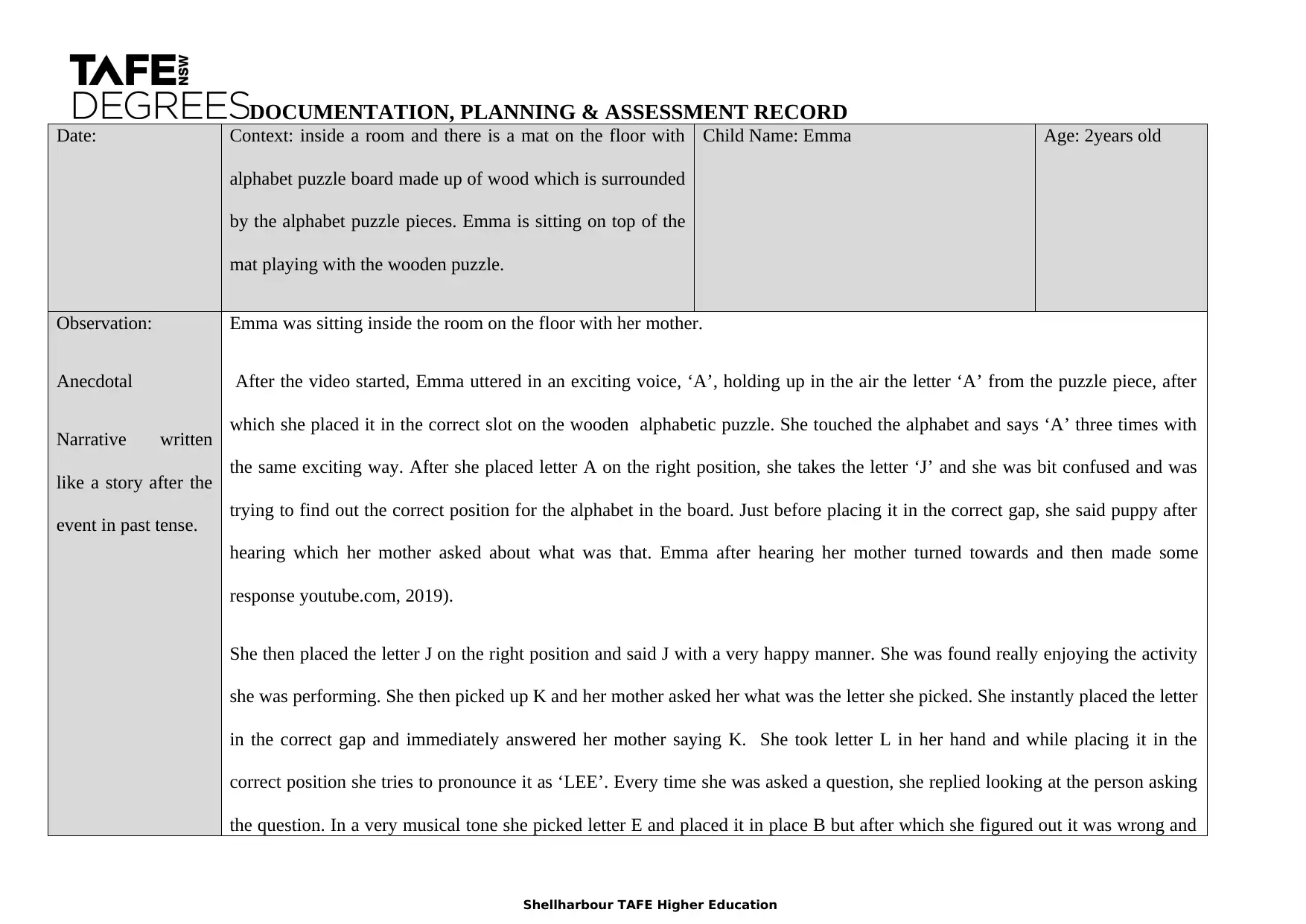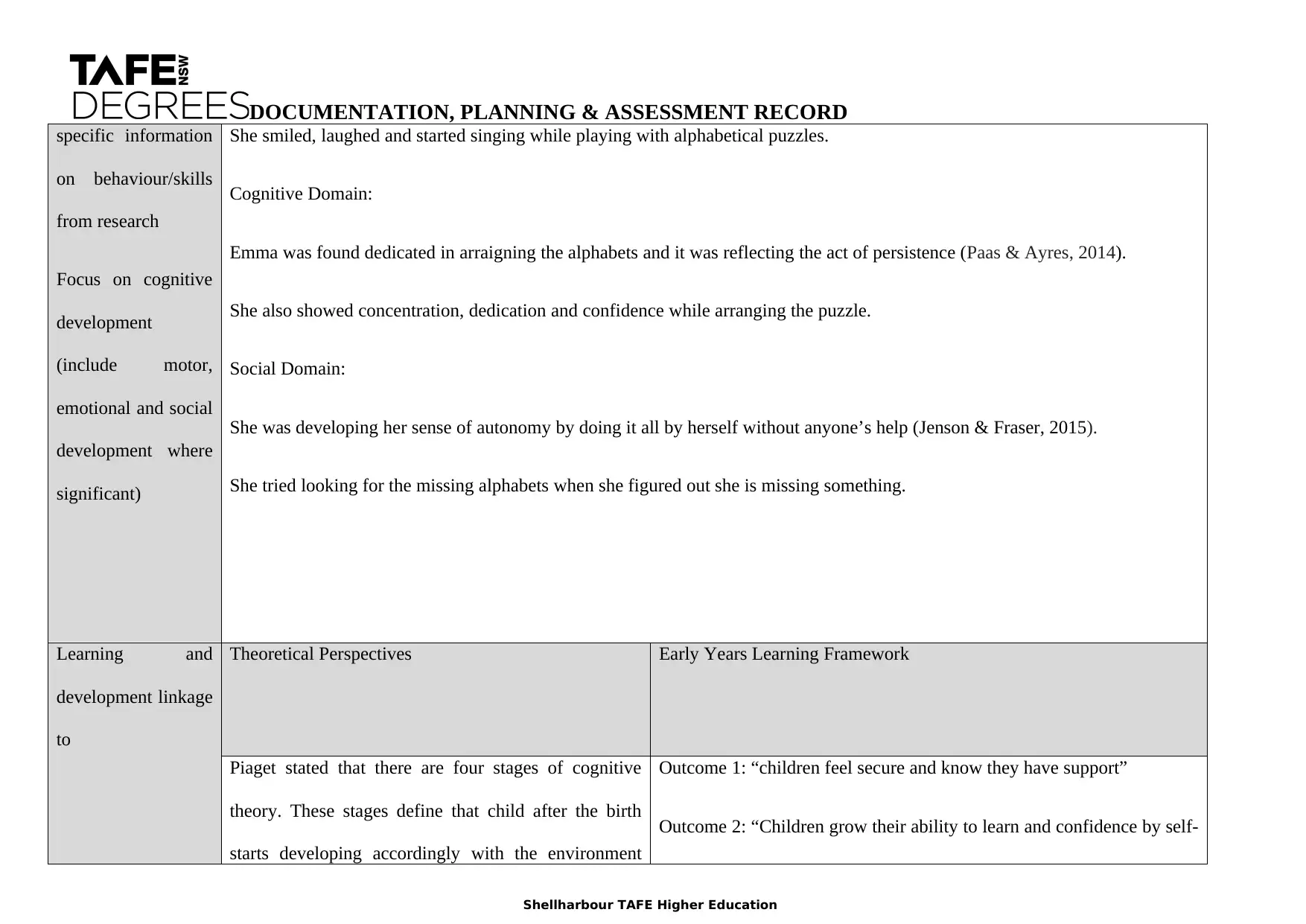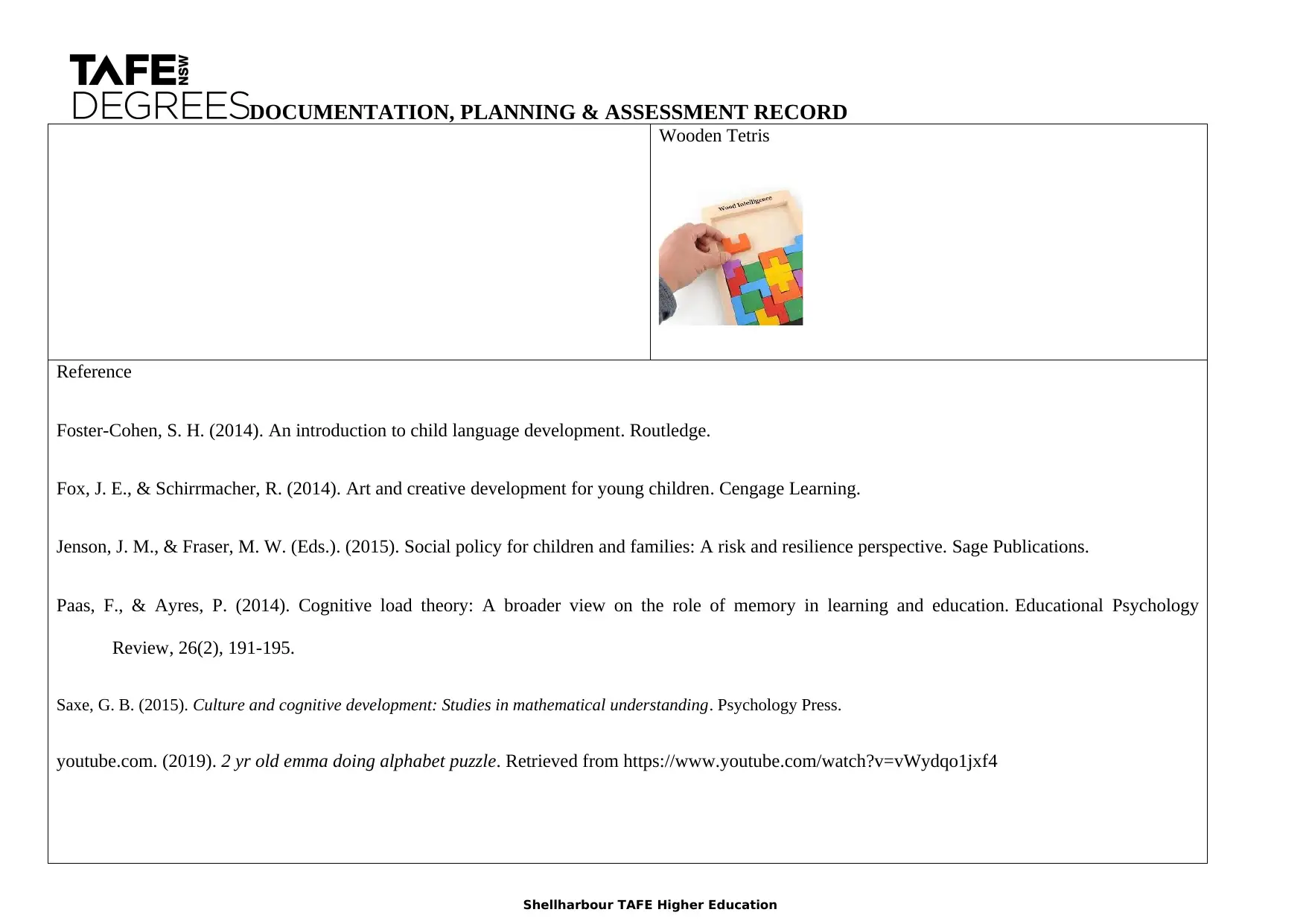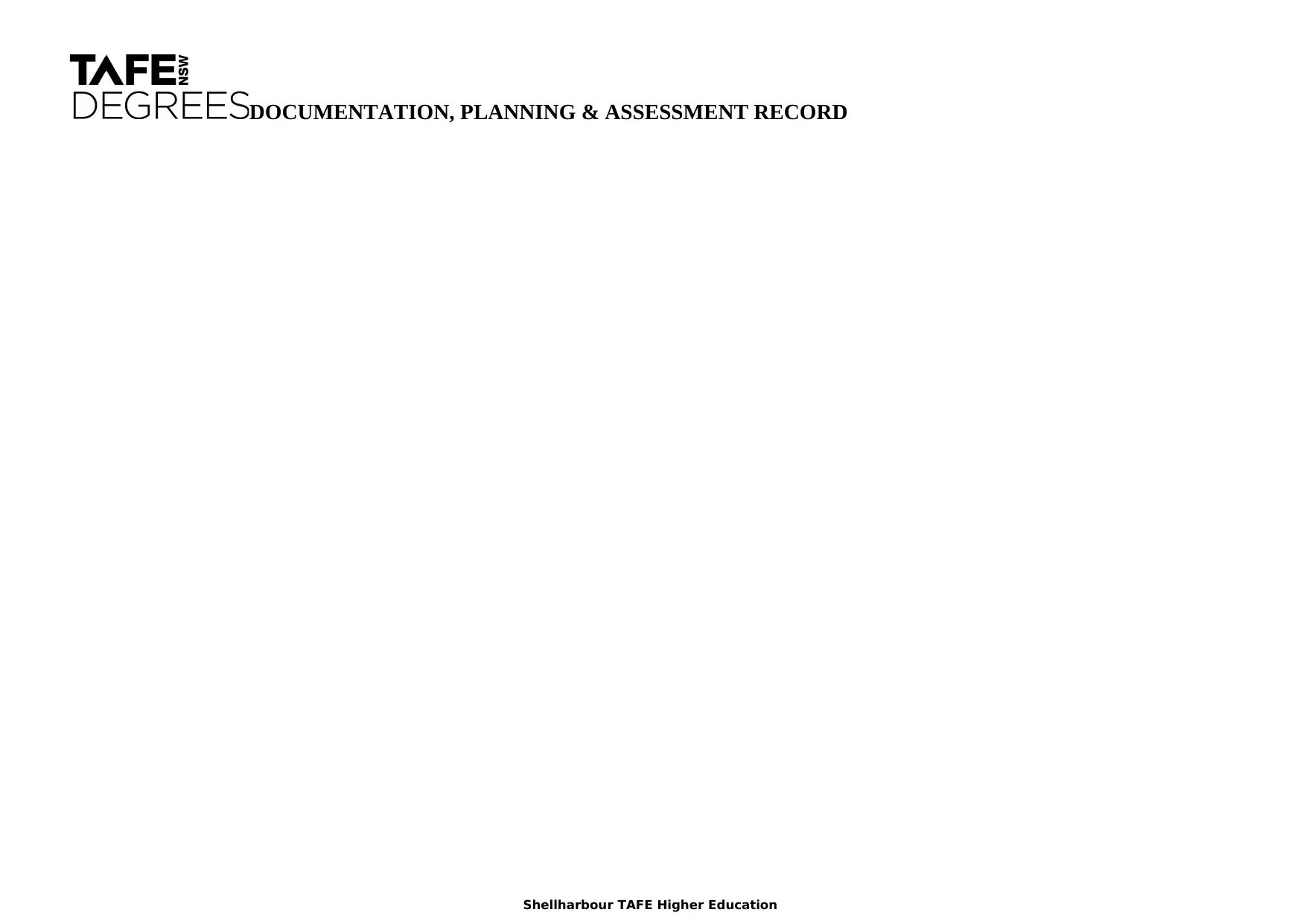Documentation, Planning & Assessment: Emma's Alphabet Puzzle Report
VerifiedAdded on 2023/01/17
|6
|1221
|39
Report
AI Summary
This report provides a detailed analysis of an observation of a 2-year-old child, Emma, interacting with an alphabet puzzle. The report includes an anecdotal narrative describing Emma's actions and verbalizations while playing with the puzzle. It interprets her skills and developmental domains, focusing on cognitive, social, and emotional development. The report references the Early Years Learning Framework and Piaget's theory of cognitive development to explain Emma's learning process. Furthermore, it identifies learning objectives and suggests future learning possibilities, such as incorporating more complex puzzles and games to foster her cognitive growth. The report is a comprehensive assessment of Emma's cognitive abilities and provides insights into her learning journey, with references to relevant research and theoretical perspectives.

DOCUMENTATION, PLANNING & ASSESSMENT RECORD
Date: Context: inside a room and there is a mat on the floor with
alphabet puzzle board made up of wood which is surrounded
by the alphabet puzzle pieces. Emma is sitting on top of the
mat playing with the wooden puzzle.
Child Name: Emma Age: 2years old
Observation:
Anecdotal
Narrative written
like a story after the
event in past tense.
Emma was sitting inside the room on the floor with her mother.
After the video started, Emma uttered in an exciting voice, ‘A’, holding up in the air the letter ‘A’ from the puzzle piece, after
which she placed it in the correct slot on the wooden alphabetic puzzle. She touched the alphabet and says ‘A’ three times with
the same exciting way. After she placed letter A on the right position, she takes the letter ‘J’ and she was bit confused and was
trying to find out the correct position for the alphabet in the board. Just before placing it in the correct gap, she said puppy after
hearing which her mother asked about what was that. Emma after hearing her mother turned towards and then made some
response youtube.com, 2019).
She then placed the letter J on the right position and said J with a very happy manner. She was found really enjoying the activity
she was performing. She then picked up K and her mother asked her what was the letter she picked. She instantly placed the letter
in the correct gap and immediately answered her mother saying K. She took letter L in her hand and while placing it in the
correct position she tries to pronounce it as ‘LEE’. Every time she was asked a question, she replied looking at the person asking
the question. In a very musical tone she picked letter E and placed it in place B but after which she figured out it was wrong and
Shellharbour TAFE Higher Education
Date: Context: inside a room and there is a mat on the floor with
alphabet puzzle board made up of wood which is surrounded
by the alphabet puzzle pieces. Emma is sitting on top of the
mat playing with the wooden puzzle.
Child Name: Emma Age: 2years old
Observation:
Anecdotal
Narrative written
like a story after the
event in past tense.
Emma was sitting inside the room on the floor with her mother.
After the video started, Emma uttered in an exciting voice, ‘A’, holding up in the air the letter ‘A’ from the puzzle piece, after
which she placed it in the correct slot on the wooden alphabetic puzzle. She touched the alphabet and says ‘A’ three times with
the same exciting way. After she placed letter A on the right position, she takes the letter ‘J’ and she was bit confused and was
trying to find out the correct position for the alphabet in the board. Just before placing it in the correct gap, she said puppy after
hearing which her mother asked about what was that. Emma after hearing her mother turned towards and then made some
response youtube.com, 2019).
She then placed the letter J on the right position and said J with a very happy manner. She was found really enjoying the activity
she was performing. She then picked up K and her mother asked her what was the letter she picked. She instantly placed the letter
in the correct gap and immediately answered her mother saying K. She took letter L in her hand and while placing it in the
correct position she tries to pronounce it as ‘LEE’. Every time she was asked a question, she replied looking at the person asking
the question. In a very musical tone she picked letter E and placed it in place B but after which she figured out it was wrong and
Shellharbour TAFE Higher Education
Paraphrase This Document
Need a fresh take? Get an instant paraphrase of this document with our AI Paraphraser

DOCUMENTATION, PLANNING & ASSESSMENT RECORD
placed it in the right place youtube.com, 2019).
Emma took the letter ‘I’ in her hand tried to twisting it so that it fit correctly in the position. She started singing and picked B and
placed it in the position where it belongs and then she took Y and when she was asked what alphabet she is holding, then she said
it was Y. She placed M and Y at the same time in their respective positions. Emma picks the letter ‘F’ and puts it in the correct
position while saying F two times rising her head youtube.com, 2019).
She placed the letter R in place of D but then she placed it in the right place and was trying to pronounce ‘R’ as ‘Ring’ after
which she picked the letter ‘G’ and the letter ‘V’ with her hand and kept it the letters in the correct slot. She was asked by her
mother one by one about the letters and she knew correctly every letter. But later she realized that she is missing with two letters
‘C’ and ‘P’ and when asked by her mother if she is sitting on them, she stands up and searches for them but didn’t finds it
(youtube.com, 2019).
Referenced
Interpretation of the
skills and/or
developmental
domains. Add
Cognitive Domain:
The children are found to learn by constructing and internalizing modelled apparatus. And through the video it was known that
she enjoyed learning through puzzles and was really good at it.
Shellharbour TAFE Higher Education
placed it in the right place youtube.com, 2019).
Emma took the letter ‘I’ in her hand tried to twisting it so that it fit correctly in the position. She started singing and picked B and
placed it in the position where it belongs and then she took Y and when she was asked what alphabet she is holding, then she said
it was Y. She placed M and Y at the same time in their respective positions. Emma picks the letter ‘F’ and puts it in the correct
position while saying F two times rising her head youtube.com, 2019).
She placed the letter R in place of D but then she placed it in the right place and was trying to pronounce ‘R’ as ‘Ring’ after
which she picked the letter ‘G’ and the letter ‘V’ with her hand and kept it the letters in the correct slot. She was asked by her
mother one by one about the letters and she knew correctly every letter. But later she realized that she is missing with two letters
‘C’ and ‘P’ and when asked by her mother if she is sitting on them, she stands up and searches for them but didn’t finds it
(youtube.com, 2019).
Referenced
Interpretation of the
skills and/or
developmental
domains. Add
Cognitive Domain:
The children are found to learn by constructing and internalizing modelled apparatus. And through the video it was known that
she enjoyed learning through puzzles and was really good at it.
Shellharbour TAFE Higher Education

DOCUMENTATION, PLANNING & ASSESSMENT RECORD
specific information
on behaviour/skills
from research
Focus on cognitive
development
(include motor,
emotional and social
development where
significant)
She smiled, laughed and started singing while playing with alphabetical puzzles.
Cognitive Domain:
Emma was found dedicated in arraigning the alphabets and it was reflecting the act of persistence (Paas & Ayres, 2014).
She also showed concentration, dedication and confidence while arranging the puzzle.
Social Domain:
She was developing her sense of autonomy by doing it all by herself without anyone’s help (Jenson & Fraser, 2015).
She tried looking for the missing alphabets when she figured out she is missing something.
Learning and
development linkage
to
Theoretical Perspectives Early Years Learning Framework
Piaget stated that there are four stages of cognitive
theory. These stages define that child after the birth
starts developing accordingly with the environment
Outcome 1: “children feel secure and know they have support”
Outcome 2: “Children grow their ability to learn and confidence by self-
Shellharbour TAFE Higher Education
specific information
on behaviour/skills
from research
Focus on cognitive
development
(include motor,
emotional and social
development where
significant)
She smiled, laughed and started singing while playing with alphabetical puzzles.
Cognitive Domain:
Emma was found dedicated in arraigning the alphabets and it was reflecting the act of persistence (Paas & Ayres, 2014).
She also showed concentration, dedication and confidence while arranging the puzzle.
Social Domain:
She was developing her sense of autonomy by doing it all by herself without anyone’s help (Jenson & Fraser, 2015).
She tried looking for the missing alphabets when she figured out she is missing something.
Learning and
development linkage
to
Theoretical Perspectives Early Years Learning Framework
Piaget stated that there are four stages of cognitive
theory. These stages define that child after the birth
starts developing accordingly with the environment
Outcome 1: “children feel secure and know they have support”
Outcome 2: “Children grow their ability to learn and confidence by self-
Shellharbour TAFE Higher Education
⊘ This is a preview!⊘
Do you want full access?
Subscribe today to unlock all pages.

Trusted by 1+ million students worldwide

DOCUMENTATION, PLANNING & ASSESSMENT RECORD
they attain and the things they are provided with.
Emma is now in the pre optional stage according to
Piaget (Saxe, 2015).
learning”
Outcome 3: ‘’Children understand the conditions and responsibilities of
their families and community and their part in an association’’
Outcome 4: “Children performing these activities increase their ability,
skills and capacities of problem solving, questioning, testing,
hypothesising and researching.”
Outcome 5: “Children are found to be valuable communicators.”
Objective for future learning and development Learning Possibilities for inclusion in the curriculum
Providing Emma with puzzles, complicated and a little tricky games will
helping her develop her capabilities and grow, as she enjoys playing with such
games and is really good at such games. (Foster-Cohen, 2014). The game
provided her with enough confidence and idea to arrange and put them in their
respective positions.( Fox & Schirrmacher, 2014).
Wooden memory chess.
Shellharbour TAFE Higher Education
they attain and the things they are provided with.
Emma is now in the pre optional stage according to
Piaget (Saxe, 2015).
learning”
Outcome 3: ‘’Children understand the conditions and responsibilities of
their families and community and their part in an association’’
Outcome 4: “Children performing these activities increase their ability,
skills and capacities of problem solving, questioning, testing,
hypothesising and researching.”
Outcome 5: “Children are found to be valuable communicators.”
Objective for future learning and development Learning Possibilities for inclusion in the curriculum
Providing Emma with puzzles, complicated and a little tricky games will
helping her develop her capabilities and grow, as she enjoys playing with such
games and is really good at such games. (Foster-Cohen, 2014). The game
provided her with enough confidence and idea to arrange and put them in their
respective positions.( Fox & Schirrmacher, 2014).
Wooden memory chess.
Shellharbour TAFE Higher Education
Paraphrase This Document
Need a fresh take? Get an instant paraphrase of this document with our AI Paraphraser

DOCUMENTATION, PLANNING & ASSESSMENT RECORD
Wooden Tetris
Reference
Foster-Cohen, S. H. (2014). An introduction to child language development. Routledge.
Fox, J. E., & Schirrmacher, R. (2014). Art and creative development for young children. Cengage Learning.
Jenson, J. M., & Fraser, M. W. (Eds.). (2015). Social policy for children and families: A risk and resilience perspective. Sage Publications.
Paas, F., & Ayres, P. (2014). Cognitive load theory: A broader view on the role of memory in learning and education. Educational Psychology
Review, 26(2), 191-195.
Saxe, G. B. (2015). Culture and cognitive development: Studies in mathematical understanding. Psychology Press.
youtube.com. (2019). 2 yr old emma doing alphabet puzzle. Retrieved from https://www.youtube.com/watch?v=vWydqo1jxf4
Shellharbour TAFE Higher Education
Wooden Tetris
Reference
Foster-Cohen, S. H. (2014). An introduction to child language development. Routledge.
Fox, J. E., & Schirrmacher, R. (2014). Art and creative development for young children. Cengage Learning.
Jenson, J. M., & Fraser, M. W. (Eds.). (2015). Social policy for children and families: A risk and resilience perspective. Sage Publications.
Paas, F., & Ayres, P. (2014). Cognitive load theory: A broader view on the role of memory in learning and education. Educational Psychology
Review, 26(2), 191-195.
Saxe, G. B. (2015). Culture and cognitive development: Studies in mathematical understanding. Psychology Press.
youtube.com. (2019). 2 yr old emma doing alphabet puzzle. Retrieved from https://www.youtube.com/watch?v=vWydqo1jxf4
Shellharbour TAFE Higher Education

DOCUMENTATION, PLANNING & ASSESSMENT RECORD
Shellharbour TAFE Higher Education
Shellharbour TAFE Higher Education
⊘ This is a preview!⊘
Do you want full access?
Subscribe today to unlock all pages.

Trusted by 1+ million students worldwide
1 out of 6
Your All-in-One AI-Powered Toolkit for Academic Success.
+13062052269
info@desklib.com
Available 24*7 on WhatsApp / Email
![[object Object]](/_next/static/media/star-bottom.7253800d.svg)
Unlock your academic potential
Copyright © 2020–2025 A2Z Services. All Rights Reserved. Developed and managed by ZUCOL.
